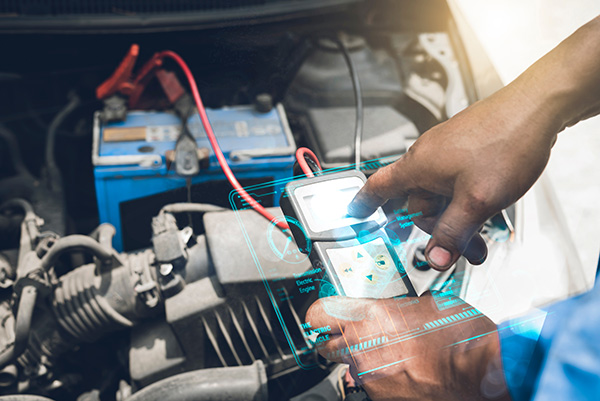
A slow morning start can mean two different things: the engine cranks slowly, or it cranks at normal speed but takes longer than usual to fire. Each points to a different set of causes.
Sorting which symptom you have is the first step to a clean fix.
What “Slow Start” Really Means
If the starter turns the engine slowly, think battery, cables, or the starter itself. If the engine spins at normal speed yet needs extra seconds before it catches, look to fuel pressure, air measurement, or sensors that control cold enrichment. A start that fires, stumbles, and dies once may hint at a dirty throttle body or an idle control problem.
Cold Batteries and Thick Oil
Batteries lose cranking power as temperatures drop. A three to five year old battery can sound fine at noon and struggle at dawn. Corroded terminals or loose grounds add resistance that steals voltage during cranking. Oil viscosity matters too. Using the manufacturer’s specified cold grade helps the engine spin freely on cold mornings. We often see night-and-day differences after a proper battery test and a simple terminal service.
Fuel Pressure That Bleeds Off Overnight
Electric pumps prime the rail when you switch the key on. If the internal check valve leaks, pressure drops while the car sits and the next morning starts with vapor instead of fuel. Leaky injectors can create the same symptoms and leave a fuel smell after start. A weak pump or clogged filter can also extend crank times, especially after the vehicle has sat for several hours.
Sensors and Airflow on Cold Starts
Engines need extra fuel when cold. A faulty coolant temperature sensor can report the wrong temperature, so the mixture is too lean or too rich. A dirty mass airflow sensor or a small vacuum leak can mimic the same problem by skewing calculations. Throttle bodies with carbon at the edge of the plate can stick and cause a start-and-stall pattern until the engine warms. A quick cleaning and an idle relearn often restore a steady first minute.
Starter and Cable Issues You Can Hear
A worn starter draws heavy current and turns slowly, sometimes with a grinding or whirring note. High resistance in the positive cable or ground strap does the same thing and can make the cables feel warm after a long crank. If the cabin lights dim hard or the radio resets during cranking, voltage drop testing will usually reveal a cable or starter that is on its way out.
How to Diagnose the Cause
- Note whether the engine cranks slowly or cranks normally but takes a long time to fire.
- Watch the dome light while you crank; a big dim suggests a battery or cable issue.
- Turn the key to “on” for two to three seconds before cranking to let the pump prime. If that shortens crank time, rail pressure is likely bleeding off.
- Listen for the fuel pump hum at key-on and for any clicking relays that repeat.
- Check battery terminals for white or green corrosion and confirm the clamps are snug.
- If it smells strongly of fuel after a long crank, stop and let vapors clear; leaking injectors could be flooding the intake.
How Professionals Diagnose Without Guesswork
Real fixes come from measurements, not guesses. Here’s the step-by-step checklist a tech uses to prove the cause before recommending parts:
- Battery and charging baseline: Test state of health and alternator output under load to rule out low-voltage surprises.
- Voltage drop while cranking: Measure across positive and ground cables during crank to catch hidden resistance in terminals, cables, or grounds.
- Fuel pressure profile: Record pressure at key-on, during crank, and after shutdown to verify the rail holds overnight and the pump/regulator behaves.
- Live scan data sanity checks: Confirm coolant temp plausibility (ECT vs. ambient), cranking RPM, and injector pulse width so the PCM’s inputs make sense.
- Throttle body and idle control: If deposits restrict airflow, clean the throttle body and perform an idle relearn to restore proper cold-start air.
- Vacuum leak hunt (cold): Smoke test the intake system when cold to find tiny leaks that seal up once metals expand.
Habits That Make Morning Stars Easier
Use the exact engine oil grade noted in the manual, especially in cooler months. Replace spark plugs on schedule so coils are not pushed to their limits on cold starts. Keep the air filter fresh to stabilize mixtures. If the car sits for days, a smart maintainer preserves battery health. Let the fuel pump finish priming before you crank, and avoid pressing the pedal on modern fuel-injected cars, which can confuse cold-start fueling.
Get Reliable Morning Starts in San Jose and Milpitas, CA with Alvin’s Auto Center
Tired of long cranks and rough first minutes? Visit Alvin’s Auto Center in San Jose and Milpitas, CA. We test batteries and starters under load, verify fuel pressure and hold, clean and relearn throttle bodies, and correct sensor or wiring faults so cold starts feel normal again.
Schedule a starting-and-charging diagnostic today. We will pinpoint the cause and set you up for quick, confident morning starts.